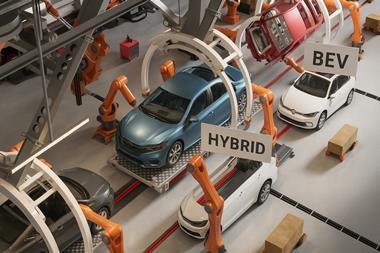
Wireless power of IPT enables AGVs to abandon the battery and operate continuously without recharging or risk of down time, writes Eberhard Vonhof of Conductix-Wampfler

AGVs have long been used for delivery and material handling in logistics and warehouse applications, where the classic battery-powered AGV is ideally suited to operate. An overnight charge is usually sufficient to permit operations through the working day, and there frequently are enough stopping points (and times) to permit charging. However, the higher-duty cycle demand in production and continuous assembly line operations do not easily present charging opportunities. Battery-operated AGVs have often failed to perform, especially in two and three shift operations. The main limiting factor is the energy storage capability of the AGV battery.
Eliminate the battery
Of course, the AGVs could have bigger batteries, but that adds cost and weight and they still need to be charged. That means ‘dead time’ for the AGVs to be parked for charging. Another solution is to add additional AGVs to the system and always have some offline in a charging station. That too is an extra cost. Assembly line AGVs tend to be larger and more expensive than delivery AGVs, with additional features such as tooling plates, lifts and fixtures. Getting battery-operated AGVs to operate through a two-shift production cycle can be a challenge. Getting them to operate continuously through three shifts is not practical. However, by eliminating the battery, the AGV is freed from these constraints.
Wireless power supply permits the AGVs to operate continuously, as if they were ‘plugged in’, but without the plug. Wireless data communication for machine control has proven to be robust and stable in the most demanding of manufacturing environments, including automotive. Wireless data is not only being used for monitoring and data acquisition, but also for machine control and safety monitoring, with multiple devices that are rated to transmit safety signals via wireless and meet safety and security standards. However, wireless power supply enables the ‘cord’ to be cut completely so the AGV can operate automatically and indefinitely.
 Battery-free AGVs have even become established in that most critical application, marriage of body and chassis
Battery-free AGVs have even become established in that most critical application, marriage of body and chassisOne advantage of logistics AGVs is their ability to free roam over large distances in a warehouse or on a factory floor. Their travel paths are flexible. There are typically a small number of AGVs covering relatively large distances, delivering material from one location to another. On-board energy storage in the form of a battery is ideal for this application. Production or assembly line AGVs, on the other hand, tend to have much more clearly defined paths since they need to interface with tooling or defined workstations and also frequently engage with other conveyors such as overhead EMS or power-and-free.
There are also typically a larger number of AGVs on assembly lines, and the routes tend to be shorter. So, there is a higher density of AGVs on the assembly line, and they are always on the go. These distinct characteristics of assembly line AGVs place unique demands on the power supply system for the conveyance, which wireless power is able to fulfil. AGVs offer a number of advantages as an assembly line conveyance compared with more traditional equipment such as chain-based conveyances.
Operationally, AGVs offer the advantages of cleanliness, low noise, improved sustainability, a safer work environment, improved operator access to the product and increased load capacity. The conveyance does not get in the way of the product. Installation of battery-free AGVs is much quicker, less expensive and far less risky than installation of chain conveyor systems. The installation does not require any pits, trenches, rails or structural steel. The installation consists of cutting two shallow slots in the concrete floor and inserting cable. The slots are filled with epoxy, resulting in a smooth flat floor.
The risk at installation is reduced because all the AGVs can be tested and debugged off site beforehand. A traditional Power and Free or EMS (electrified monorail system) needs to be tested and debugged on site (unusually during a summer or year-end shutdown) under high pressure within a tight schedule. AGVs can operate in a number of different modes, either as an indexing line or a continuously moving line. They even provide the flexibility to operate differently within various zones, changing speeds, index spacing, and stopping locations based on the AGV and the product it contains. These are all reconfigurable by software without any physical hardware changes.
The financial advantages of AGVs include the fact that the investment is portable. Compared with a traditional conveyance where 75-80% of the conveyance is infrastructural, with battery-free AGVs only the wireless power supply cables in the floor are tied to the building. About 90% of the capital investment can easily be relocated. The investment is scalable. It is easy to phase in more AGVs as capacity growth requires, without the need for full scale capacity investment at the outset. The investment is flexible.
Expanding or modifying the conveyance to accommodate different configurations and products is easily accomplished by changing the number of AGVs, the AGV paths, or the AGV tooling. In contrast, a typical chain conveyor would need to be almost entirely replaced. There is significantly less maintenance and downtime associated with battery-free AGVs, resulting in better use of the equipment and reduced maintenance labour and material costs.
Greater sustainability is achieved with wireless AGVs, since they don’t require batteries, and require significantly fewer raw materials than chain-based conveyance. They also don’t require any toxic chemicals for maintenance other than occasional lubrication for wheels.
Energy and power
The main challenge for AGV batteries is typically energy, not power. Is there enough energy in the batteries to keep the AGV running all day, rather than is the battery powerful enough to handle the heaviest load? When the batteries are eliminated from the AGV, and it is powered wirelessly from the floor, then the primary focus becomes power.
So, when sizing an IPT system, the peak and average power requirements of the individual AGVs need to be considered. Also the peak and average power requirements of the combined system whereby the duty cycle and simultaneous factor of the AGVs are taken into account.
Inductive Power Transfer (IPT) technology has been commercially available since the 1990s. Contrary to popular belief, loosely coupled inductive power systems are more efficient that battery-powered systems. The efficiency of the inductive coupling between primary and secondary in an IPT system is in the order of 96%. This is much better than batteries, which are typically only able to return 80% of the charging energy applied.
Summary and conclusions
Chain conveyors have been around for over a century. The first conveyor systems used in the mass production of automobiles were chain conveyors. It is unlikely that chain conveyors will completely disappear from automotive manufacturing any time soon.
Battery-powered AGVs have been used for many years, however primarily in material handling rather than as assembly line conveyances. Battery induced limitations (battery life, charging, disposal, required infrastructure) make them less attractive for assembly line applications.
Battery-free AGVs, powered and controlled completely wirelessly have the ability to operate indefinitely, sustainably, with minimal maintenance, and lower risk of down time. This coupled with the inherent system flexibility, and reduced cost and risk at installation means that they have found acceptance as assembly line conveyances, even in the most critical of all automotive applications, the marriage (of body and chassis).
Battery-free AGVs have established their place among assembly line conveyances, providing a good return on investment with low total cost of ownership.
The author would like to thank RedViking for providing helpful background information and application photographs for this article.








































